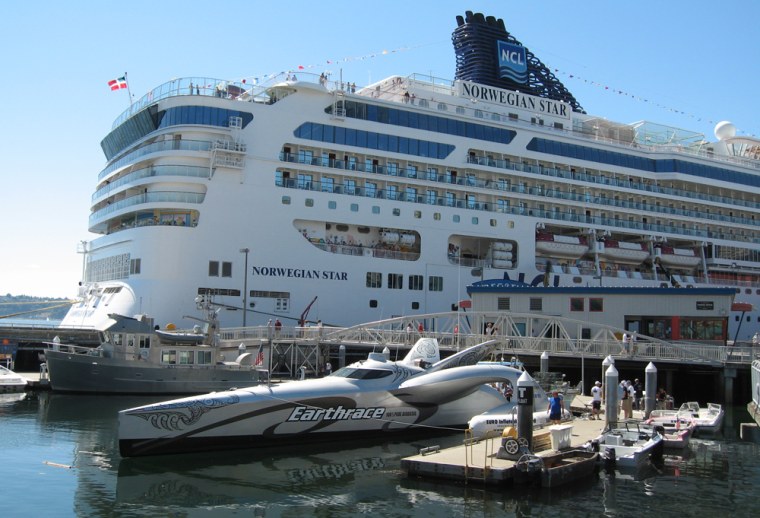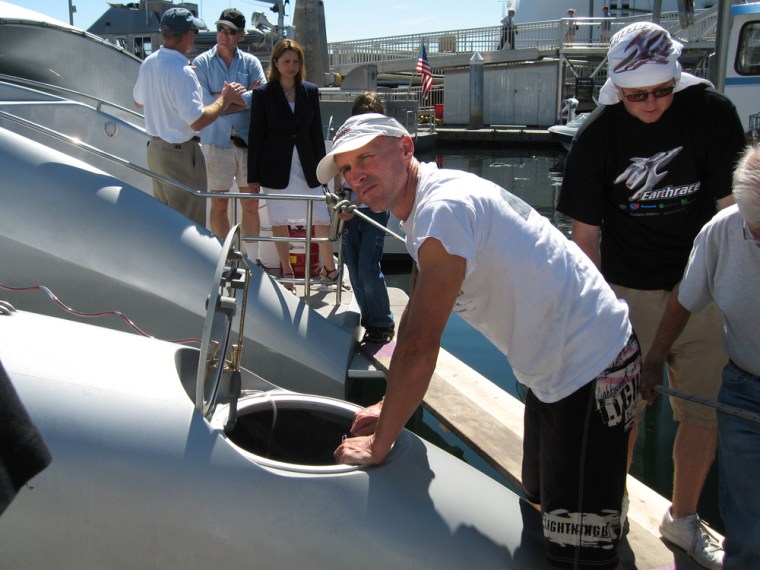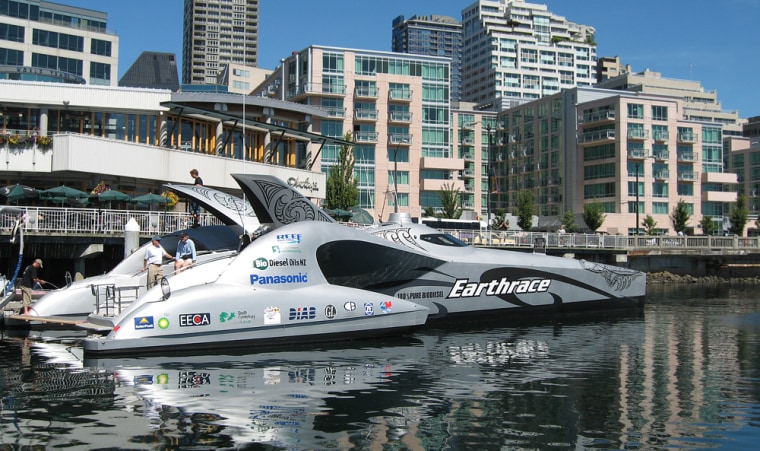SEATTLE — Some guys enter mid-life on a Harley. Peter Bethune is doing it on a $2.5 million boat that he hopes will smash the record for fastest powerboat trip around the world.
But for all the muscle embodied by his boat, Bethune's biggest passion is what fuels the machine: biodiesel, a cleaner alternative to diesel that can be made from soybeans, used vegetable oil and even animal fat.
The New Zealand native and former oil industry engineer doesn't have any qualms about using his 540-horsepower craft to tout cleaner energy. It's all about visibility, he says, and the boat certainly has that. It measures 78 feet long and has a needlenose bow and curved pontoons that make it look more like a Star Wars prop than a powerboat. But the design isn't for show: The pointed bow allows the craft to pierce waves instead bobbing over them and a travel at a more constant speed than regular powerboats, saving time and energy.
Bethune is showing off the boat on a six-month tour of North American ports. His message is it's easy to be environmentally friendly, even in the ostentatious world of powerboating.
"I don't want to encourage conspicuous consumption," he says of huge powerboats. "I'm keen to see the boating industry become a lot greener. But we're not anti-fun and you don't have to become a hermit" and shun life's pleasures to protect the environment, he says.
Biodiesel benefits
Ethanol fuel, which is typically made from corn or sugar, has gotten most of the renewable energy spotlight in recent months because it can run in gasoline engines.
But Bethune, 41, wants to show that biodiesel is a good match for boats, which often have diesel engines.

While emissions of smog-forming nitrogen oxide can be slightly higher with biodiesel than with diesel, emissions of particulate matter, a possible carcinogen, and carbon dioxide, a gas many scientists tie to global warming, are greatly reduced.
Biodiesel also smells better. "Certainly more palatable than diesel," Bethune says of the exhaust from his boat's two huge engines. Most of the time.
Some biodiesel is made from animal fat, producing what the crew describes as a rank slaughterhouse smell. But most is made from soybeans, for a smell the sailors liken to "fish and chips with a bit of diesel."
Bethune runs 100 percent biodiesel in the engines, but advises other boaters to use a blend of up to 25 percent so they don't run into problems from poorly filtered biodiesel that could gunk up engines. That's the same advice often given to owners of diesel cars. Boaters should also be warned that manufacturers are reluctant to warranty their engines if more than 5 percent biodiesel is used, although that is changing as biodiesel gains acceptance.
Debt strategy
Promoting biodiesel has been the easiest part of Bethune's adventure. The hardest has been finding money.
Bethune and his motley crew of volunteers scramble at every stop looking for sponsors, even hitting up curious passers-by for $5 donations to help pay the bills.
"Getting cash was really tough and we were very, very poor at it," says Bethune. Of the $3 million spent on the boat so far, about half has come from sponsors providing equipment, services or fuel. The other half is personal debt, much of it cash Bethune got by refinancing the family home three times.

"We were on a knife's edge" last December, he recalls, until a Dubai-based friend from his oil days came through with a $100,000 loan.
That was enough to get the tour started, first around New Zealand, then to Hawaii, Vancouver and now the U.S. West Coast.
But there's no money to pay the four crewmen — adventurers like Ryan Heron, 23, who shelved pursuing a career as a film cameraman to videotape the journey and finding someone to underwrite a documentary.
"I slowly got suckered into the team," he says with a smile. "But the trip itself is pretty cool."
What the team really lacks is a sugar daddy — a rich boating aficionado, someone like billionaire Paul Allen. "It's hard meeting guys like that," Bethune says. "We sometimes get a friend of a friend of a rich guy but that channel has always broken down."
Around the world in 60 days?
For now, the team lives day by day, port to port. Themarinersplan to cross the Panama Canal and then make stops along the East Coast, including New York City from Sept. 30 through Oct. 5. After that it's through the St. Lawrence Seaway into the Great Lakes and to Chicago, where they will stop Nov. 10-12, and then down the Mississippi River, finishing in New Orleans from Nov. 30 to Dec. 3.
The team hopes to set off in March from Barbados, in the Caribbean, for the round-the-world record attempt.
Designed by the Craig Loomes Yacht Design Group and built by Calibre Boats, two New Zealand companies, the powerboat holds 2,500 gallons of fuel, allowing for long stretches between refueling.
The round-the-world powerboat record, set in 1998, is 75 days. Bethune predicts beating that by 10 to 15 days, "if nothing goes wrong, and there's a lot that can go wrong."
The journey from New Zealand proved that when the boat struck a small log, damaging the hull. Had it been a bit bigger it could have sunk the boat, Bethune says. Even more dangerous could be the thousands of containers that litter the seas — cargo lost by ships that bob just a few inches above the water line.
Adventure but no glamour
Then there are the living conditions. Only the pilot and copilot get seats, and the bunks are crammed in the forward part of the boat. The kitchen is a toaster and a microwave. There's a toilet, when it works, which wasn't the case in Seattle, but no shower.
Living conditions will be even more difficult during the round-the-world voyage. Bethune figures he and his crewmembers will have to stay locked inside the craft a third of the time as it pierces waves in rougher seas. The engines reach 85 decibels, about as loud as a garbage disposal, making it next to impossible to hear anything else.
When not piloting, crewmembers either sit or lie down on the bunks where they can work on e-mail, read and sleep. Or they can stand in the 5-foot-long kitchen galley.
Cramped quarters
"Mentally, it will be tough keeping the crew motivated when it's hot and sweaty (inside)," Bethune says.
Physically, there's "the brutality of punishing your body" during long ocean sprints at 20 or 25 knots an hour, Bethune says. It's actually not bad when the boat, which is designed to submerge up to 25 feet at a time, pierces a wave. The boat shudders a bit but the hull takes most of the impact.
What takes a toll on the crew is the constant physical jostling they endure when the waves aren't big enough to go under and the boat has to punch a wave, dip into the bottom of the swell and then bounce off the next wave — over and over again.
But Bethune is in his element powering across the high seas. "I don't regret anything," he says. "I get to work on something I'm passionate about."
Upcoming tour stops, as well as background on the Earthrace boat, are online at
